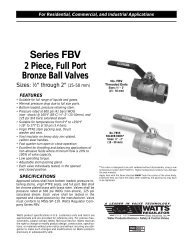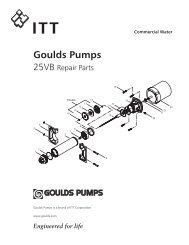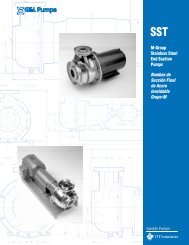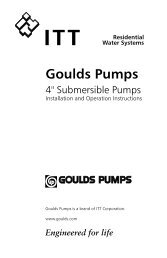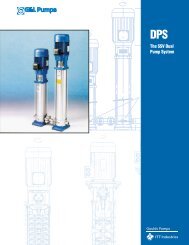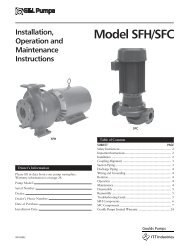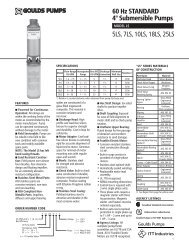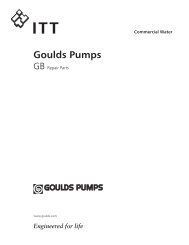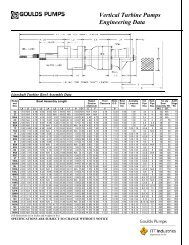4" Submersible Pumps
4" Submersible Pumps
4" Submersible Pumps
You also want an ePaper? Increase the reach of your titles
YUMPU automatically turns print PDFs into web optimized ePapers that Google loves.
leads. See the instructions for<br />
checking three phase unbalance in<br />
the Technical Section of this<br />
manual. Failure to check phase<br />
unbalance can cause premature<br />
motor failure and nuisance overload<br />
tripping. If using a generator,<br />
see Technical Data for generators.<br />
5.0 STARTING<br />
THE PUMP<br />
CAUTION<br />
Hazardous pressure can<br />
cause personal injury or<br />
property damage.<br />
5.1 Throttling<br />
Discharge On<br />
Start-Up<br />
If the pump will be<br />
operated to clear the well<br />
and/or operate with no pressure or<br />
very little head we strongly suggest<br />
you throttle the discharge. Install a<br />
ball valve in the discharge line.<br />
Open the valve to approximately<br />
1 ⁄3 open on system start-up. After<br />
starting, use the valve to adjust the<br />
flow. This will prevent upthrust<br />
damage to the pump and motor<br />
bearings. It will also keep the pump<br />
running in its recommended<br />
operating range. Starting or running<br />
a pump with little or no head is a<br />
major cause of premature failure.<br />
CAUTION<br />
Hazardous pressure can<br />
cause personal injury or<br />
property damage.<br />
5.2 Throttling A<br />
High Static<br />
Level Well To<br />
Prevent Upthrust<br />
Any well with a high<br />
static water level may allow the<br />
pump to operate off the curve to<br />
the right or outside the<br />
“Recommended Range” shown on<br />
the pump curve. We recommend<br />
using a “Dole” flow restrictor or<br />
throttling with a ball valve to<br />
prevent upthrust damage to the<br />
pump and motor. The maximum<br />
flow must be restricted to be within<br />
the pumps recommended operating<br />
range. If you use a ball valve, set it,<br />
remove the handle, tape the handle<br />
to the pipe, and tag the valve with a<br />
note saying, “Do not open this<br />
valve or pump may be damaged”.<br />
The easiest way to “set” the flow is<br />
to fill a 5 gallon bucket and time<br />
how long it takes to produce 5<br />
gallons. Calculate the flow in gpm<br />
based on this value. As the water<br />
level drops in the well the flow will<br />
be reduced due to increased head<br />
and the valve will not interfere with<br />
performance.<br />
5.3 Start the Pump<br />
Partially open a valve (faucet) in the<br />
system and turn the breaker to the<br />
ON position.<br />
Check all fittings for leaks.<br />
Close the valve when the water<br />
clears and allow the pressure to<br />
build. If properly adjusted the<br />
switch should turn the pump off at<br />
the preset pressure. Open a few<br />
faucets and allow the pump to run<br />
through a few cycles. Check switch<br />
operation and verify that pressure<br />
settings are correct.<br />
Recheck all fittings for leaks.<br />
6.0 PAPERWORK<br />
and IOM<br />
Please give the owner all warranty<br />
and IOM paperwork. It is wise to<br />
include your business card with the<br />
Goulds <strong>Pumps</strong> supplied paperwork.<br />
A sticker with your name and<br />
phone number on the tank or<br />
control box is a great sales tool for<br />
future business!<br />
Congratulations on completing a<br />
professional installation of a Goulds<br />
Pump.<br />
9



